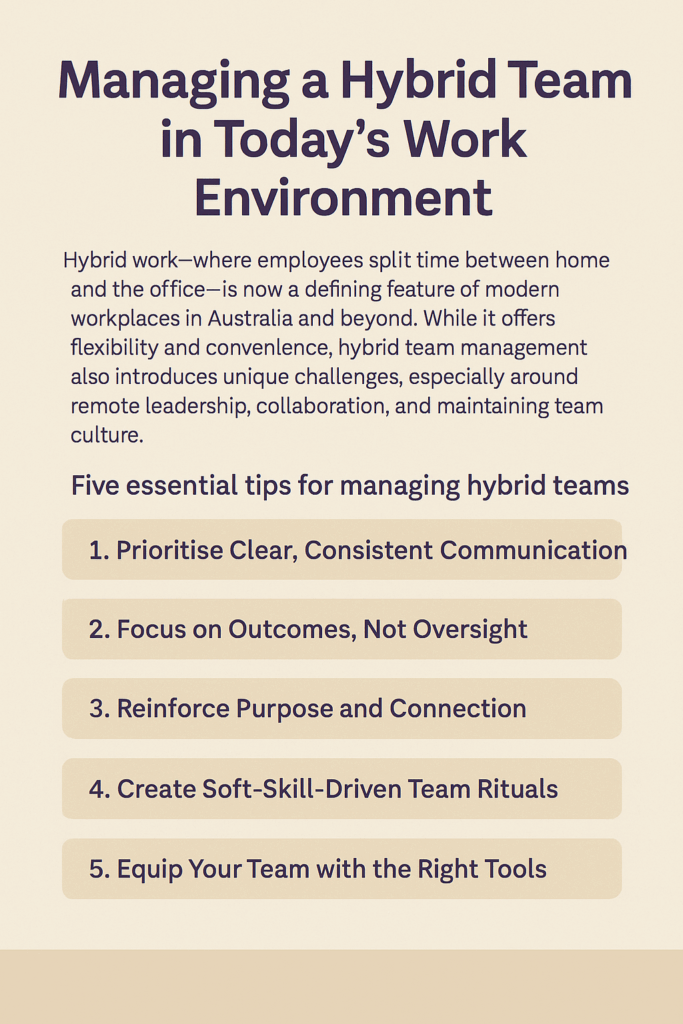Hybrid Teams Are the New Normal
Hybrid work—where employees split their time between home and the office—is now a defining feature of modern workplaces in Australia and beyond. While it offers flexibility and convenience, Hybrid team management also introduces unique challenges, especially around remote leadership, collaboration, and maintaining team culture.
Without the right strategy, the blend of in-person and remote work can lead to communication breakdowns, misalignment, and inconsistent performance. But with clear expectations, thoughtful leadership, and the right tools, Hybrid teams can thrive.
Here are five essential tips for managing a successful Hybrid team:
1. Prioritise Clear, Consistent Communication
In Hybrid environments, remote communication skills are critical. You can no longer rely on casual office interactions to share updates or clarify misunderstandings. Instead, build communication routines that keep everyone aligned—whether they’re in the office or dialing in from home.
Schedule regular, purposeful check-ins—short daily stand-ups or twice-weekly catch-ups—to ensure clarity and cohesion. Keep meetings brief (15–30 minutes), structured, and outcome-focused. Hybrid teams benefit from agendas that make the most of limited time together.
2. Focus on Outcomes, Not Oversight
One of the biggest pitfalls in Hybrid work is the temptation to micromanage from a distance. Instead, adopt a leadership style focused on trust, accountability, and performance outcomes.
Set clear expectations, define deliverables, and empower your team to manage their time and tasks. This approach not only fosters autonomy but also builds psychological safety—a key driver of Hybrid team productivity.
3. Reinforce Purpose and Connection
Without regular face-to-face interaction, Hybrid team members can feel disconnected or lose sight of their purpose. Strong digital team leadership means helping people stay connected to the “why” behind their work.
Use the “Why-What-How” framework in team discussions:
Why – The greater purpose or customer impact
What – The outcomes the team is delivering
How – The tasks, values, or behaviours that drive results
A renewed sense of purpose leads to greater commitment, resilience, and collaboration across locations.
4. Create Soft-Skill-Driven Team Rituals
Soft skills in Hybrid teams—like empathy, emotional intelligence, and presence—can make or break your culture. Help your team establish new rituals that support focus, wellbeing, and connection.
Ideas include:
Weekly “wellbeing check-ins” to build empathy and support
Scheduled no-meeting focus blocks for deep work
Encouraging professional attire on video calls to signal readiness and professionalism
The goal is to cultivate habits that support both performance and human connection.
5. Equip Your Team with the Right Tools
Managing online collaboration depends on having the right digital infrastructure. Invest in tools that simplify teamwork and reduce friction—whether your team is in the office, remote, or both.
Look for platforms that offer:
Real-time document collaboration
Clear task tracking and project visibility
Seamless messaging and video communication
Great tools don’t just make work easier—they support a culture of transparency and trust across Hybrid teams.
Evolving as a Hybrid Leader
Remote leadership in Australia now demands more than just adapting—it requires transforming the way we lead. Leaders who embrace flexibility, foster human connection, and build trust across distances will unlock the full potential of their teams.
If you’re navigating the complexities of Hybrid team management, you’re not alone. Our leadership programs are designed to equip you with the digital team leadership and soft skills needed to thrive.
📞 Want support? Call us at 1300 551 274 or email team@teamfocusplus.com.
Let’s work together to create a high-performing, connected Hybrid team.
Check out our Team Development Solutions page







